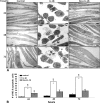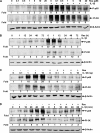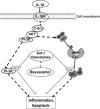Resveratrol modulates interleukin-1β-induced phosphatidylinositol 3-kinase and nuclear factor κB signaling pathways in human tenocytes
- PMID: 22936809
- PMCID: PMC3488075
- DOI: 10.1074/jbc.M112.377028
Resveratrol modulates interleukin-1β-induced phosphatidylinositol 3-kinase and nuclear factor κB signaling pathways in human tenocytes
Abstract
Resveratrol, an activator of histone deacetylase Sirt-1, has been proposed to have beneficial health effects due to its antioxidant and anti-inflammatory properties. However, the mechanisms underlying the anti-inflammatory effects of resveratrol and the intracellular signaling pathways involved are poorly understood. An in vitro model of human tenocytes was used to examine the mechanism of resveratrol action on IL-1β-mediated inflammatory signaling. Resveratrol suppressed IL-1β-induced activation of NF-κB and PI3K in a dose- and time-dependent manner. Treatment with resveratrol enhanced the production of matrix components collagen types I and III, tenomodulin, and tenogenic transcription factor scleraxis, whereas it inhibited gene products involved in inflammation and apoptosis. IL-1β-induced NF-κB and PI3K activation was inhibited by resveratrol or the inhibitors of PI3K (wortmannin), c-Src (PP1), and Akt (SH-5) through inhibition of IκB kinase, IκBα phosphorylation, and inhibition of nuclear translocation of NF-κB, suggesting that PI3K signaling pathway may be one of the signaling pathways inhibited by resveratrol to abrogate NF-κB activation. Inhibition of PI3K by wortmannin attenuated IL-1β-induced Akt and p65 acetylation, suggesting that p65 is a downstream component of PI3K/Akt in these responses. The modulatory effects of resveratrol on IL-1β-induced activation of NF-κB and PI3K were found to be mediated at least in part by the association between Sirt-1 and scleraxis and deacetylation of NF-κB and PI3K. Overall, these results demonstrate that activated Sirt-1 plays an essential role in the anti-inflammatory effects of resveratrol and this may be mediated at least in part through inhibition/deacetylation of PI3K and NF-κB.
Figures















Similar articles
-
Sirt-1 is required for the inhibition of apoptosis and inflammatory responses in human tenocytes.J Biol Chem. 2012 Jul 27;287(31):25770-81. doi: 10.1074/jbc.M112.355420. Epub 2012 Jun 11. J Biol Chem. 2012. PMID: 22689577 Free PMC article.
-
Curcumin modulates nuclear factor kappaB (NF-kappaB)-mediated inflammation in human tenocytes in vitro: role of the phosphatidylinositol 3-kinase/Akt pathway.J Biol Chem. 2011 Aug 12;286(32):28556-66. doi: 10.1074/jbc.M111.256180. Epub 2011 Jun 13. J Biol Chem. 2011. PMID: 21669872 Free PMC article.
-
IGF-1 and PDGF-bb suppress IL-1β-induced cartilage degradation through down-regulation of NF-κB signaling: involvement of Src/PI-3K/AKT pathway.PLoS One. 2011;6(12):e28663. doi: 10.1371/journal.pone.0028663. Epub 2011 Dec 14. PLoS One. 2011. PMID: 22194879 Free PMC article.
-
Targeting extracellular matrix remodeling in disease: Could resveratrol be a potential candidate?Exp Biol Med (Maywood). 2017 Feb;242(4):374-383. doi: 10.1177/1535370216675065. Epub 2016 Oct 23. Exp Biol Med (Maywood). 2017. PMID: 27798117 Free PMC article. Review.
-
Phosphoinositide 3-kinase/Akt and its related signaling pathways in the regulation of tumor-associated macrophages polarization.Mol Cell Biochem. 2022 Oct;477(10):2469-2480. doi: 10.1007/s11010-022-04461-w. Epub 2022 May 19. Mol Cell Biochem. 2022. PMID: 35590082 Review.
Cited by
-
Resveratrol-Induced Signal Transduction in Wound Healing.Int J Mol Sci. 2021 Nov 23;22(23):12614. doi: 10.3390/ijms222312614. Int J Mol Sci. 2021. PMID: 34884419 Free PMC article. Review.
-
The Protective Effect of Magnolol in Osteoarthritis: In vitro and in vivo Studies.Front Pharmacol. 2019 Apr 16;10:393. doi: 10.3389/fphar.2019.00393. eCollection 2019. Front Pharmacol. 2019. PMID: 31040782 Free PMC article.
-
Global Responses of Il-1β-Primed 3D Tendon Constructs to Treatment with Pulsed Electromagnetic Fields.Cells. 2019 Apr 30;8(5):399. doi: 10.3390/cells8050399. Cells. 2019. PMID: 31052237 Free PMC article.
-
Sirt1 Is Required for Resveratrol-Mediated Chemopreventive Effects in Colorectal Cancer Cells.Nutrients. 2016 Mar 5;8(3):145. doi: 10.3390/nu8030145. Nutrients. 2016. PMID: 26959057 Free PMC article.
-
Role of polyphenolics in the management of rheumatoid arthritis through intracellular signaling pathways: a mechanistic review.Inflammopharmacology. 2025 May;33(5):2263-2275. doi: 10.1007/s10787-025-01731-z. Epub 2025 Apr 12. Inflammopharmacology. 2025. PMID: 40220198 Review.
References
-
- Alvares O., Klebe R., Grant G., Cochran D. L. (1995) Growth factor effects on the expression of collagenase and TIMP-1 in periodontal ligament cells. J. Periodontol. 66, 552–558 - PubMed
-
- Tewari D. S., Qian Y., Tewari M., Pieringer J., Thornton R. D., Taub R., Mochan E. O. (1994) Mechanistic features associated with induction of metalloproteinases in human gingival fibroblasts by interleukin-1. Arch. Oral. Biol. 39, 657–664 - PubMed
-
- Baldwin A. S., Jr. (1996) The NF-κB and IκB proteins. New discoveries and insights. Annu. Rev. Immunol. 14, 649–683 - PubMed
-
- Kumar A., Takada Y., Boriek A. M., Aggarwal B. B. (2004) Nuclear factor-κB. Its role in health and disease. J. Mol. Med. 82, 434–448 - PubMed
-
- Malinin N. L., Boldin M. P., Kovalenko A. V., Wallach D. (1997) MAP3K-related kinase involved in NF-κB induction by TNF, CD95 and IL-1. Nature 385, 540–544 - PubMed
MeSH terms
Substances
LinkOut - more resources
Full Text Sources
Miscellaneous

